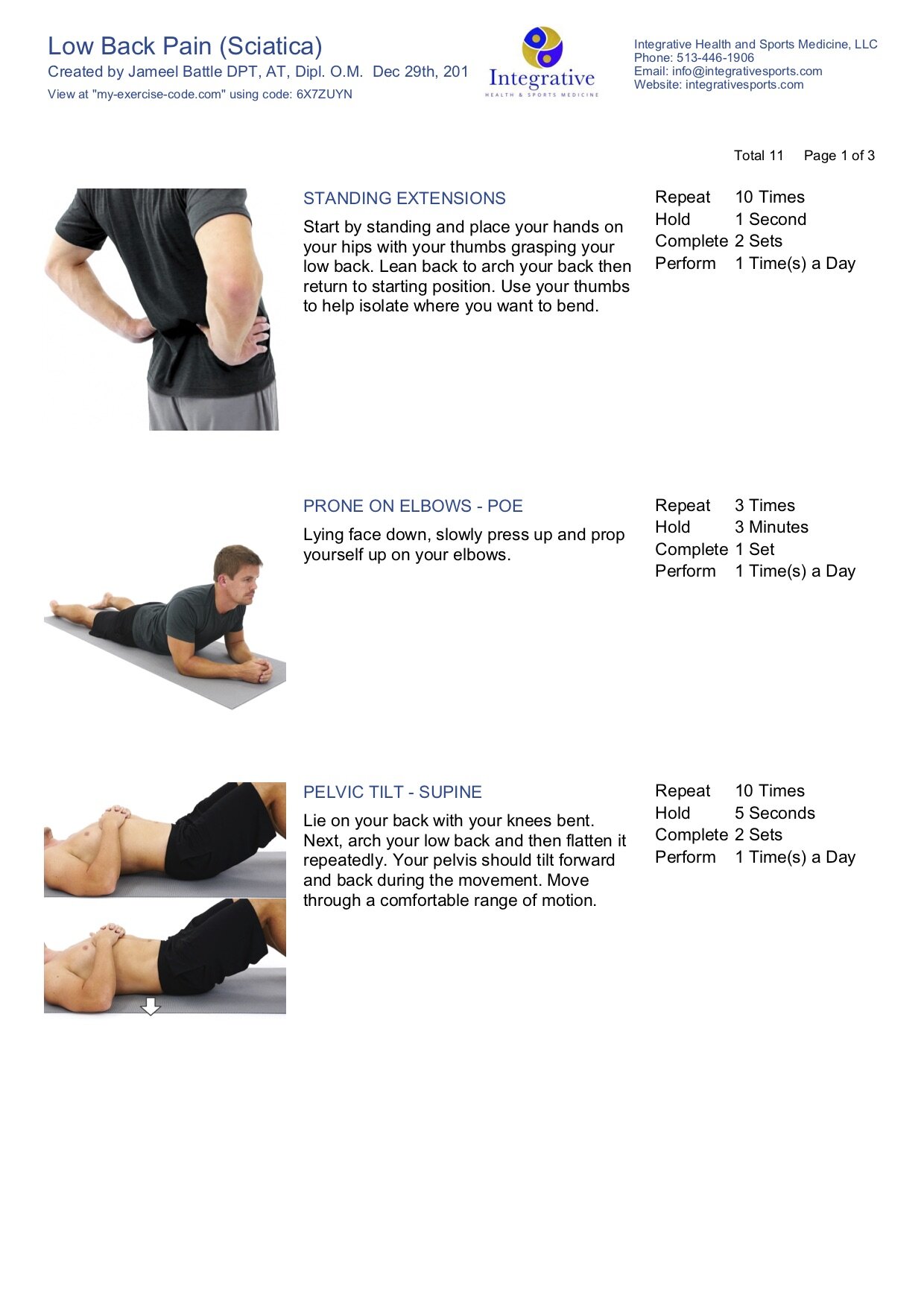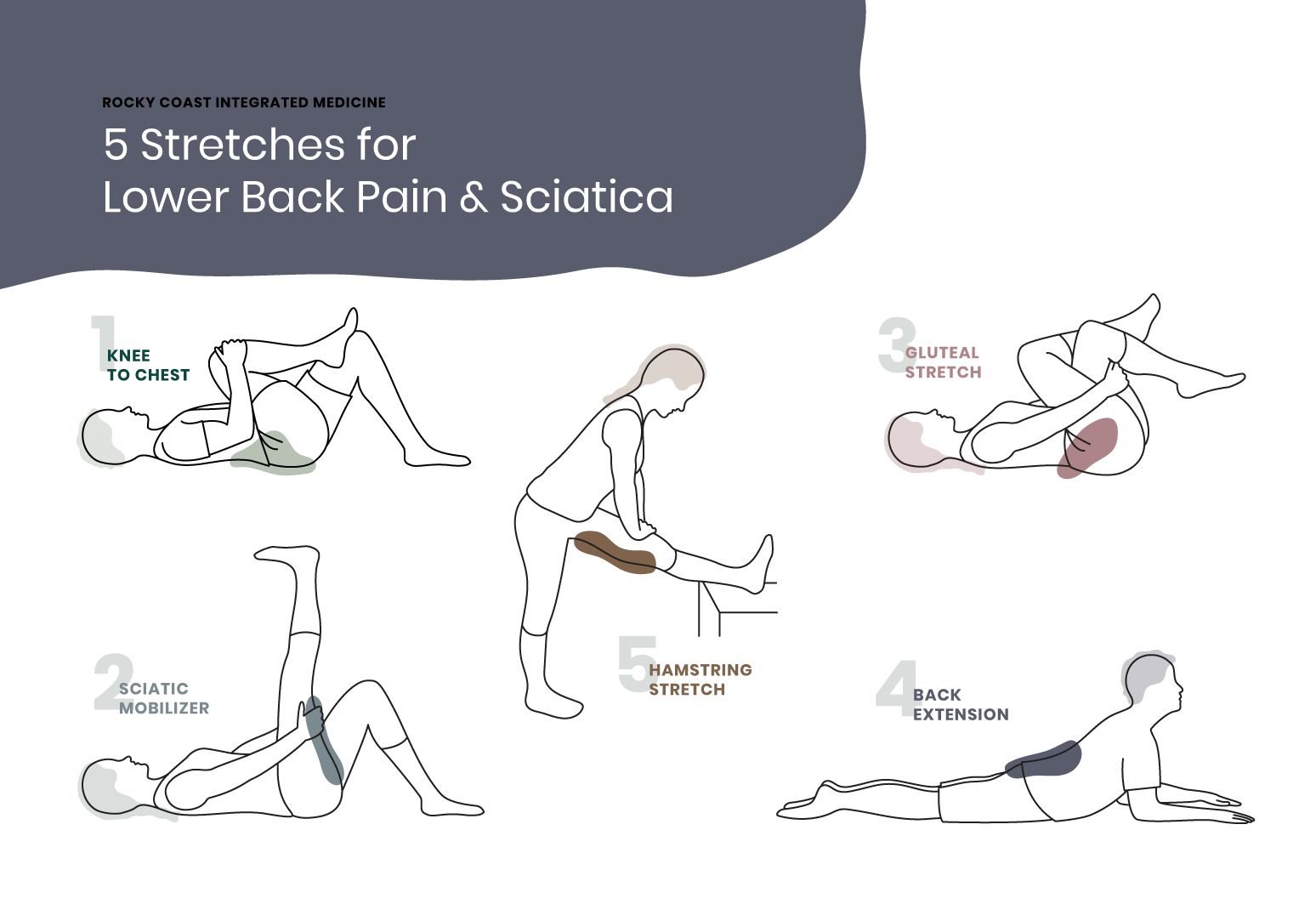Exercises for low back pain and sciatica can relieve discomfort and improve mobility. Consistent practice of targeted exercises is essential.
Low back pain and sciatica affect millions worldwide, causing significant discomfort and limiting daily activities. Specific exercises can alleviate pain and enhance mobility. Regular stretching and strengthening routines target the muscles supporting the spine, reducing strain and promoting healing. Incorporating these exercises into your daily routine can lead to long-term relief and prevent future issues.
It’s crucial to perform these exercises correctly to avoid further injury. Consulting with a physical therapist can provide personalized guidance. Embracing an active lifestyle and maintaining a healthy weight also contribute to overall spine health. By committing to these exercises, you can manage and reduce low back pain and sciatica effectively.
Introduction To Low Back Pain And Sciatica
Low back pain and sciatica are common problems. They affect many people worldwide. Pain in the lower back can make daily tasks difficult. Sciatica is pain that travels down the leg. It happens when the sciatic nerve is irritated. Exercises can help relieve these pains. This blog will guide you through the best exercises.
The Prevalence Of Back Issues
Back pain is widespread. It affects people of all ages. Millions of people suffer from it every year. Many factors contribute to back pain. These include poor posture, heavy lifting, and lack of exercise. Sciatica is also common. It often occurs due to herniated discs. These issues can disrupt daily life.
Symptoms Of Low Back Pain And Sciatica
Low back pain can vary. It may be dull, sharp, or burning. Some people feel stiffness in their back. Others may find it hard to move. Sciatica has specific symptoms. These include:
- Pain radiating down one leg
- Numbness or tingling in the leg
- Weakness in the leg or foot
- Increased pain when sitting
Exercises To Relieve Pain
Exercises can help manage low back pain and sciatica. They strengthen muscles and improve flexibility. Here are some effective exercises:
| Exercise | Description |
|---|---|
| Pelvic Tilts | Lie on your back with knees bent. Tighten your stomach muscles. Push your back into the floor. Hold for 5 seconds. Repeat 10 times. |
| Knee-to-Chest Stretches | Lie on your back. Bring one knee to your chest. Hold for 20 seconds. Switch legs. Repeat 5 times per leg. |
| Cat-Cow Stretch | Start on hands and knees. Arch your back like a cat. Then lower it like a cow. Repeat 10 times. |
| Seated Forward Bend | Sit with legs extended. Reach towards your toes. Hold for 20 seconds. Repeat 3 times. |

Credit: www.integrativesports.com
Causes Behind The Pain
Low back pain and sciatica can be frustrating and debilitating. Understanding the causes can help manage and relieve the pain. Let’s dive into the common triggers and what sets off sciatica.
Common Triggers For Low Back Pain
Low back pain can arise from various sources. Here are some common triggers:
- Muscle Strain: Overstretching or tearing muscles.
- Herniated Discs: Discs pressing on nerves.
- Poor Posture: Slouching and improper sitting.
- Obesity: Extra weight puts pressure on the spine.
- Age: Degenerative changes in the spine.
Sciatica: What Sets It Off?
Sciatica is caused by irritation of the sciatic nerve. Here are some common causes:
- Spinal Stenosis: Narrowing of the spinal canal.
- Spondylolisthesis: Slipped vertebrae pressing on the nerve.
- Piriformis Syndrome: Muscle spasms irritating the nerve.
- Trauma: Injuries causing nerve compression.
- Prolonged Sitting: Constant pressure on the sciatic nerve.
| Cause | Description |
|---|---|
| Muscle Strain | Overstretching or tearing muscles. |
| Herniated Discs | Discs pressing on nerves. |
| Spinal Stenosis | Narrowing of the spinal canal. |
| Obesity | Extra weight puts pressure on the spine. |
| Poor Posture | Slouching and improper sitting. |
Understanding these triggers can help you take preventive measures. Consulting a healthcare professional for personalized advice is always a good idea.
Importance Of Exercise For Recovery
Exercise plays a crucial role in recovering from low back pain and sciatica. It helps improve mobility, strengthen muscles, and reduce pain. This section highlights the importance of movement and the balance between exercise and rest.
How Movement Aids Healing
Movement promotes blood flow to affected areas. This helps deliver essential nutrients and oxygen. Improved circulation accelerates the healing process.
Exercise reduces inflammation and stiffness. It also prevents muscles from weakening. Engaging in physical activity releases endorphins. These natural painkillers help manage discomfort.
Low-impact exercises like walking and stretching are beneficial. They keep the spine flexible without causing additional strain. Regular movement also improves posture, reducing stress on the back.
Exercise Vs. Rest: The Balance
Finding the right balance between exercise and rest is key. Over-exercising can worsen symptoms. Too much rest can lead to muscle atrophy.
Follow a structured exercise plan. Include a mix of strengthening, stretching, and low-impact activities. Listen to your body. If you feel pain, take a break.
Incorporate rest periods into your routine. Alternate between activity and rest to avoid overexertion. This balance ensures effective recovery and long-term well-being.
| Exercise Type | Benefits |
|---|---|
| Stretching | Increases flexibility and reduces stiffness |
| Strengthening | Builds muscle support for the spine |
| Low-Impact Activities | Improves circulation without adding strain |
- Start with gentle exercises to avoid injury.
- Gradually increase intensity as your condition improves.
- Consult a healthcare professional for personalized advice.

Credit: www.youtube.com
Starting With Gentle Stretches
Low back pain and sciatica can be debilitating. Starting with gentle stretches helps alleviate pain and improve mobility. These stretches should be simple and easy to perform. They aim to relax the muscles and reduce tension.
Stretching Basics
Begin with a warm-up to prepare your muscles. A gentle walk or light movements can suffice. Always listen to your body and avoid overextending. Ensure you perform each stretch slowly and hold it for at least 20 seconds. Repeat each stretch 2-3 times for optimal benefit.
Recommended Stretches For Beginners
- Knee-to-Chest Stretch: Lie on your back with knees bent. Pull one knee towards your chest, holding it with both hands. Hold for 20 seconds, then switch legs.
- Child’s Pose: Kneel on the floor, sitting on your heels. Extend your arms forward and lower your torso. Hold for 20 seconds, focusing on deep breathing.
- Piriformis Stretch: Lie on your back with knees bent. Cross one leg over the other, placing the ankle on the opposite knee. Pull the bottom leg towards your chest and hold.
- Cat-Cow Stretch: Start on all fours. Arch your back (cat pose) and then dip it down (cow pose). Move slowly between each position.
- Hamstring Stretch: Sit with one leg extended and the other bent. Reach towards your toes on the extended leg and hold.
| Stretch | Position | Duration |
|---|---|---|
| Knee-to-Chest | Lie on back | 20 seconds |
| Child’s Pose | Kneeling | 20 seconds |
| Piriformis Stretch | Lie on back | 20 seconds |
| Cat-Cow | All fours | 20 seconds |
| Hamstring Stretch | Sitting | 20 seconds |
Starting with these gentle stretches can help manage low back pain and sciatica. Remember to stay consistent and patient with your progress.
Strength Training For Core Support
Strength training for core support is crucial for managing Exercises for Low Back Pain And Sciatica. A strong core stabilizes your spine, reducing strain on your back. This can alleviate pain and prevent future injuries.
Building A Stronger Core
To build a stronger core, focus on exercises targeting your abdominal muscles. These muscles support your spine and improve posture. Engage in activities like planks and crunches to strengthen your core.
| Exercise | Description |
|---|---|
| Planks | Hold a plank position for 30 seconds, keeping your body straight. |
| Crunches | Lie on your back and lift your shoulders off the ground. |
Exercises To Enhance Core Stability
Core stability exercises help maintain balance and support your lower back. Try exercises like bridges and leg raises to enhance stability. These exercises engage multiple muscle groups, providing better support.
- Bridges: Lie on your back, lift your hips, and hold for 10 seconds.
- Leg Raises: Lie flat and lift your legs to a 45-degree angle.
Incorporate these exercises into your routine for a stronger, more stable core. This can reduce low back pain and improve your overall health.
Aerobic Exercises For Overall Fitness
Low back pain and sciatica can be debilitating. But aerobic exercises can help. Aerobic exercises boost overall fitness and alleviate pain. Let’s explore the benefits and safe options.
Benefits Of Aerobic Exercise
Aerobic exercises increase heart rate and improve circulation. This helps deliver more oxygen to muscles, promoting healing. Aerobic exercise also strengthens the cardiovascular system.
- Improves Mood: Releases endorphins, reducing stress and anxiety.
- Boosts Energy: Enhances stamina and reduces fatigue.
- Supports Weight Management: Helps burn calories and maintain a healthy weight.
Safe Aerobic Options For Those With Back Pain
Choose low-impact aerobic exercises to avoid straining your back. Here are some safe options:
- Walking: A gentle way to stay active. Start with short walks and gradually increase the distance.
- Swimming: Provides full-body workout without stressing the back. Water buoyancy supports your body, reducing impact.
- Cycling: Use a stationary bike to control intensity. Ensure proper posture to avoid strain.
Engaging in these aerobic exercises can boost your overall fitness. Always consult a healthcare professional before starting any exercise regimen.
Mind-body Techniques For Pain Management
Managing Exercises for Low Back Pain And Sciatica can be challenging. Mind-body techniques offer a natural way to ease discomfort. These methods focus on the connection between the mind and body. They help reduce pain and improve overall well-being.
The Role Of Mindfulness
Mindfulness involves being present in the moment. It helps people become aware of their body and mind. This awareness can reduce stress and pain. Practicing mindfulness daily can improve back health.
- Meditation
- Deep breathing exercises
- Body scans
These techniques promote relaxation and reduce muscle tension. They are simple to practice and require no equipment.
Yoga And Pilates For Back Health
Yoga and Pilates strengthen core muscles. A strong core supports the spine. These exercises also improve flexibility and posture.
| Yoga Poses | Pilates Exercises |
|---|---|
| Child’s Pose | The Hundred |
| Cat-Cow Stretch | Pelvic Tilts |
| Downward Dog | Swan Dive |
Practicing these poses regularly can alleviate back pain. They also enhance overall body strength and stability.

Credit: www.onestep.co
When To Seek Professional Help
Low back pain and sciatica can disrupt daily life. While exercises can help, sometimes professional help is needed. This section will guide you on recognizing the signs and exploring care options.
Signs You Need A Specialist
Some symptoms indicate the need for a specialist. Watch for these signs:
- Severe pain that doesn’t improve with exercises.
- Numbness or weakness in your legs.
- Loss of bladder or bowel control.
- Pain after an injury, like a fall or accident.
- Unexplained weight loss with back pain.
Physical Therapy And Chiropractic Care Options
Two common professional treatments are physical therapy and chiropractic care. Each has unique benefits.
| Physical Therapy | Chiropractic Care |
|---|---|
| Focus on exercises and stretches. | Focus on spinal adjustments. |
| Improves strength and flexibility. | Relieves pressure on nerves. |
| Uses heat, ice, and massage. | Uses hands-on manipulation. |
Both therapies aim to reduce pain and improve mobility. Your doctor can help you choose the best option.
Remember, seeking professional help can lead to quicker recovery and better health.
Incorporating Exercise Into Daily Life
Living with low back pain and sciatica can be challenging. Incorporating exercise into daily life can help manage pain. It can also improve overall well-being. Here are some practical tips to stay active and create a sustainable exercise routine.
Tips For Staying Active With Back Pain
- Start Slowly: Begin with light exercises. Gradually increase intensity.
- Listen to Your Body: Stop if you feel pain or discomfort.
- Stretch Regularly: Stretching helps improve flexibility and relieve tension.
- Use Supportive Gear: Wear comfortable shoes and use a supportive mat.
- Hydrate: Drink plenty of water to keep your muscles hydrated.
Creating A Sustainable Exercise Routine
Consistency is key to managing Exercises for Low Back Pain And Sciatica. Follow these steps to create a routine that works for you:
- Set Realistic Goals: Start with small, achievable goals. Gradually increase them.
- Schedule Workouts: Set a specific time for exercise. Stick to it daily.
- Mix It Up: Include a variety of exercises to keep things interesting.
- Track Your Progress: Keep a journal of your activities. Note improvements.
- Stay Motivated: Reward yourself for reaching milestones.
Here’s a simple table for a weekly exercise plan:
| Day | Exercise | Duration |
|---|---|---|
| Monday | Walking | 30 minutes |
| Tuesday | Stretching | 20 minutes |
| Wednesday | Swimming | 30 minutes |
| Thursday | Yoga | 30 minutes |
| Friday | Strength Training | 20 minutes |
| Saturday | Walking | 30 minutes |
| Sunday | Rest | — |
Regular exercise for make a big difference in managing Low Back Pain And Sciatica. Stay active and take care of your body.
Preventing Future Episodes Of Pain
Preventing future episodes of low back pain and sciatica is essential. By adopting the right lifestyle changes and management strategies, you can reduce the risk of recurring pain. Below are some practical steps to help keep your back healthy and pain-free.
Lifestyle Changes For Back Health
Making simple lifestyle changes can significantly improve your back health. Implement these tips to strengthen your back:
- Maintain a healthy weight: Extra weight strains your back.
- Exercise regularly: Strengthen your core muscles with exercises like planks and bridges.
- Quit smoking: Smoking reduces blood flow to your spine.
- Practice good posture: Sit and stand up straight.
- Lift properly: Bend your knees, not your waist.
Long-term Management Strategies
Consistent management strategies can help prevent future episodes of back pain. Consider incorporating these into your routine:
- Physical Therapy: Regular sessions can improve your back strength and flexibility.
- Yoga: Yoga enhances flexibility and reduces stress, which can relieve back pain.
- Ergonomic Adjustments: Use ergonomic chairs and desks to support your back.
- Heat and Cold Therapy: Alternate between heat packs and ice packs for pain relief.
- Regular Check-ups: Visit your doctor for regular back health assessments.
Implement these strategies to keep your back strong and pain-free for the long term.
Conclusion: Embracing A Pain-free Future
Exercises for Low Back Pain And Sciatica can be challenging. But, with the right exercises, a pain-free future is possible. Regular exercise strengthens muscles, improves posture, and reduces pain. Let’s summarize the key takeaways and encourage your healing journey.
Summarizing Key Takeaways
- Stretching exercises improve flexibility and reduce stiffness.
- Core strengthening supports the spine and lowers pain.
- Aerobic activities enhance overall fitness and blood flow.
- Consistency is vital for effective pain management.
Encouragement For The Healing Journey
Stay committed to your exercises. Progress may be slow, but every step counts. Celebrate small wins and stay positive. Your pain-free future is within reach.
| Exercise | Benefit |
|---|---|
| Cat-Cow Stretch | Increases spine flexibility |
| Bridges | Strengthens lower back muscles |
| Walking | Improves cardiovascular health |
Remember, your dedication to these exercises can lead to lasting relief. Embrace your journey to a pain-free future with confidence and optimism.
Frequently Asked Questions
What Exercises Help With Low Back Pain?
Exercises like pelvic tilts, bridges, and bird-dogs can help relieve low back pain. These exercises strengthen core muscles and improve flexibility. Always consult a healthcare provider before starting any exercise routine.
Can Stretching Alleviate Sciatica Pain?
Yes, stretching exercises like hamstring stretches and piriformis stretches can help alleviate sciatica pain. These stretches relieve pressure on the sciatic nerve. Perform stretches gently and regularly for best results.
How Often Should I Exercise For Low Back Pain?
Aim to exercise 3 to 5 times a week to manage low back pain. Consistency is key for effective pain relief. Always follow a balanced routine that includes stretching and strengthening exercises.
Are There Any Exercises To Avoid With Sciatica?
Avoid high-impact activities like running and heavy lifting if you have sciatica. These can worsen symptoms. Focus on low-impact exercises and stretches recommended by a healthcare provider.
Conclusion
Regular exercise can greatly reduce low back pain and sciatica. Gentle stretches and strengthening exercises are key. Always consult a healthcare provider before starting any new exercise routine. Consistency and proper technique will help you find relief and improve your quality of life.
Start your journey to a pain-free back today.




Leave a Reply